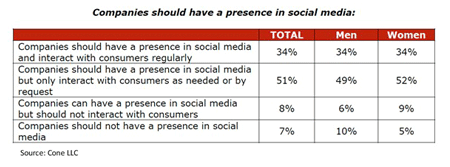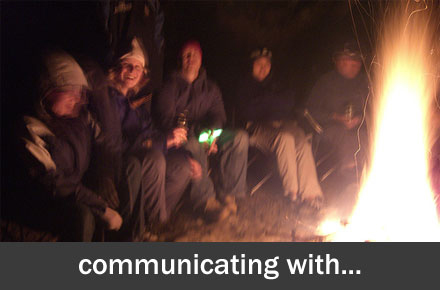Post Category: Digital Marketing
3 Oct, 2008 According to a new study by Cone, a strategy and communications agency, you and I are among the sixty percent (and rising) of Americans who use social media. More interestingly, among those of us who use social media, the vast majority—93%—expect companies to have a social media presence.

Your customers want to engage and communicate with you online. If your business does not have a social media strategy yet, it’s clearly time to develop one. Here are a few tips to get you started in the right direction:
- Start by listening. What are your customers saying about you online?
- Join and add value to the conversation by responding to feedback.
- Be genuine.
Don’t confuse “Web 2.0” technology and design patterns with communication. Social media is not about Ajax, tag clouds, RSS feeds and embedded Flash video players. Social media is about sharing content and having conversations. Those of us who do want to engage with your business online are not looking for a sales pitch.
7 Sep, 2008 Over the years, both as a contractor and within an agency, I have had the opportunity to work with great and not-so-great clients. Just like any relationship, selecting and working with the right clients is vital to the success of any project. Here are five tips to help ensure that you are involved (and stay involved) in a healthy client relationship.
Personality is Important
It’s no fun to work with people that you don’t get along with. During the proposal/pitch process, in addition to showing your potential client how wonderful you are, make sure that you are also evaluating what it might be like to work for the client. Are they open and clear about their needs, their budget, their schedule? Do they seem reasonable? Do they respect your time? Do they have a sense of humor? If the client doesn’t seem like the kind of person that you’d like to spend an hour or two with, seriously reconsider how much you need the project.
Build & Foster Trust
Every healthy relationship is based on trust; it’s no different for a professional relationship with your clients. Is your client being open and honest with you? Are you being open and honest with your client? Are both of you delivering on promises? Trust is difficult to build but very easy to ruin. If you cannot trust your client, or vice versa, it’s time to work hard to establish trust or walk away from the relationship.
Seth Godin talks about an easy way to build trust: show up on time, and respect others’ time:
The simplest test of trustworthiness for most people is whether or not you keep your promises, and the first promises you make are about time.
Clarify Everything
Yes… everything. Do you and your client both agree on the functionality of a blog? Do you see eye-to-eye on the definition of content? Do the words “clean” and “modern” mean the same thing to you and your client? This is not as easy as it sounds, but it’s important to remember. Don’t be afraid to ask questions to clarify and define anything that may be ambiguous, and put it in writing. Functional requirements documents are a great way to protect yourself and make sure that the client is going to get what they expect.
Don’t be afraid to revise an initial estimate, renegotiate or walk away from the project if you and your client’s original expectations no longer mesh.
Project or Partnership?
Have you been hired to complete a specific task on a specific project, or are you engaging in a partnership with a client? These are very different roles which require different levels of information, client-management styles and relationships. Partnerships are more collaborative in nature; they are more about adding value to a client’s overall business. Clients who seek successful partnerships with outside agencies must be willing to share more information than they do with contractors hired to complete a specific task.
Communication
Clients and contractors who keep the lines of communication wide open have the best chance at achieving success. Building relationships, clarifying expectations and building trust all rely on honest, clear and direct communication. If you and your client aren’t communicating with each other, the project and the relationship are not succeeding.
22 Aug, 2008 During yesterday’s Mzinga/Cramer webcast (#mzcramer on Twitter), “Taming the Monster Issues with Social Media Marketing,” the panelists (including yours truly) discussed some important issues facing marketers interested in entering the untamed world of online social media. As user generated content takes hold and anyone with an Internet connection is given a voice (or a megaphone), it is essential that businesses rethink their marketing strategies.
Old School Marketing is Uni-Directional

During the Twentieth Century, most marketing was unidirectional. The few who held the power to communicate with the largest audiences were able to spread and maintain control over their message. There was very little listening in this marketing model; brands and messaging were created and controlled from the top-down with scarce customer feedback. Marketers who cut their teeth on this style of polished, one-way broadcast messages (and there are quite a few of you) must evolve as people’s communication patterns evolve. It is time to listen and communicate with your customers.
Social Media Marketing is About Communication

As I stated during the webcast, the Twentieth Century was a communications anomaly. Throughout history humans have shared messages through words and images within personal social networks… communities. These communities tended to be localized and modest in size, but word of mouth marketing (both good and bad) reigned. We are entering an age when word of mouth marketing—social media—is not only reclaiming its dominance, it is obliterating the idea of uni-directional, controlled brand messages.
Today’s technology provides anyone with the ability to easily re-edit and publish your television commercial, pontificate on your products or expose proprietary information. Corporate and political press agents and spin doctors will no longer have weeks or days to do their jobs because the user-generated messages can spread across the globe to millions of connected users at the speed of light.
Marketers, the Twentieth Century is over; show your human side, and build a community with your customers. It’s time to start listening. Be sincere, and build trust.
4 May, 2008 Admit it—you’ve Googled yourself; we all have. It can be surprising (or alarming depending on your perspective) to see how many search results turn up when performing the ego search. What kind of content is returned when you enter your name into a search engine? Is the information personal? Is it favorable? What about your business or products; what are people saying across the web about your brand?
Every day, millions of people are going online and creating content. Remember when we were Time Magazine’s Person of the Year? The combination of search engines indexing billions of pages of content and the social web have given millions of people a megaphone to broadcast their messages to a global audience. Sometimes that message can be unflattering, embarrassing or downright false, and Google’s search results don’t discriminate between approved brand messaging and an irate customer.

Fortunately, there are tools available to help businesses detect valuable user feedback by monitoring online conversations.
As noted earlier, Search Engines are a reliable way to locate online content that is being published about your brand. Unfortunately, depending on the search term, sifting through several pages of results can be time consuming. Moving beyond the standard search engines, the following are useful applications which can enable marketers to monitor social media:
- Blogpulse – search and other tools targeted around content found on blogs
- Technorati – another search tool specializing in blog content
- Twing – this tool locates content specifically on message boards and forums
- Summize – what are people saying about you on the micro-blogging site: Twitter?
Rather than spending hours manually sorting through search results, Google Alerts will deliver the results straight to your email account. Users can set up alerts in no time, just enter the search term(s) that you want Google to monitor, define the type of search (Video, Blog, News, All, etc.) to be performed and how often you’d like to view results. This method is the most effective for searches that contain unique keywords: like “Kiekbusch” or “adjustafresh”.
Google and Yahoo! allow users to create custom RSS news feeds (similar to the Google Alert, but delivered via RSS) that will automatically aggregate content and push it through users’ RSS feed reader of choice.
In addition to the aforementioned tools, there are, of course, businesses like Andiamo Systems and PopularMedia that are developing algorithms specifically to monitor and track corporate reputations and buzz.
You’re Listening, Now What? Engagement
Now that it is clear how to monitor content on the web, the next step is developing a Social Media Engagement Strategy (SMES). Each corporate culture is unique and each should approach social media engagement differently with an understanding of possible privacy, public relations, marketing, legal and regulatory concerns. Does your business want to be proactive or reactive; have a distinct voice or let your customers do most of the talking; create content or collect content? Whatever engagement strategy is best for your business, there are some general best practices to consider when becoming involved with social media:
- Build trust
- Develop relationships with consumers
- Be transparent & respectful
- Facilitate a dialogue
Above all, it is imperative to remember that your customers control the message in social media—this is a bottom-up philosophy that many senior marketing and brand managers find uncomfortable. Rather than attempting to control the conversation, let your brand be the catalyst for conversation– the campfire around which people gather to connect and converse with one another. This mentality goes a long way to promote a positive corporate image online and off.
25 Mar, 2008 A couple weeks ago, I noticed Google experimenting with a new user interface pattern in their search results: another search input field. The search within a search raises some questions from both usability and marketing points of view. Is this unexpected UI pattern beneficial for end-users; does it help users more easily discover what they’re looking for; and what will be the effect on content owners whose sites Google is searching?
Search Within a Search User Experience Issues
When it comes to using an online search engine, Google has conditioned nearly every Internet user on what to expect. Empty input field, submit, page with results ordered by relevance and some unobtrusive advertisements. Not very complicated, and it gets the job done. Over the past few years, Google has experimented with adding new features to the search results page including suggested search refinement terms, image and video results (viewable within the results page), maps, stock quotes and more. For the most part, these features have enhanced the results page and user experience, unobtrusively providing users of the search engine with valuable disambiguation and helping them discover relevant data.
The latest enhancement, another search entry form, (which is nothing more than the “site:” advanced operator that Google has employed for years), may cause some confusion among less experienced users. The presence of multiple search entry fields on the same page (who’s to say they will stop at two?) is bound to challenge those of us who don’t sit in front of a computer most of the day. I’ll be very interested to learn more about usability test results of this feature among novice users.
Implications for Businesses
The potential UX issues are minor compared to what the search within search results means for businesses. Google is wisely attempting to get users to spend more time on Google search results pages, looking at ads that earn Google money. The down side for businesses is users are spending less time on their sites, looking at their products and clicking on their advertisements.
For example, consider this use case:
Clearly, this is good for Google and bad for Best Buy, and other businesses that make money selling products or online advertising. Fortunately, Google honors requests to remove businesses from the search within search feature. I am a little surprised that they’ve taken an opt out rather than an opt in approach.
What do you think? Will the new feature stick? Does the user benefit outweigh the downside for online retailers?



